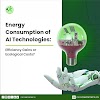Machine Learning is a field of artificial intelligence that focuses on developing algorithms and models that enable computer systems to learn and make predictions or decisions without being explicitly programmed.
There are three subcategories of machine learning:
- Supervised machine
- Unsupervised machine
- Reinforcement machine
Potential Climatic Impacts on the Machine Learning Industry
We can't manage what we don't measure, goes the old business adage.
This rings true more than ever today as the world faces a triple planetary crisis of climate change, nature and biodiversity loss, pollution, and waste. More climate data is available than ever before, but how that data is accessed, interpreted and acted on is crucial to managing these crises. One technology that is central to this is Artificial Intelligence (AI).
Here are some ways AI has been helping:
- Informing real-time analysis: UNEP's World Environment Situation Room (WESR), launched in 2022, is one digital platform that is leveraging AI's capabilities to analyze complex, multifaceted datasets.
- Monitoring methane emissions:
The platform operates as a global public database of empirically verified methane emissions. It leverages AI to strategically interconnect this data with action on science, transparency, and policy to inform data-driven decisions.
Machine Learning & Green Jobs
Machine learning plays a crucial role in the provision of new green jobs. As societies worldwide strive to transition to more sustainable and environmentally friendly practices, machine learning offers several benefits that can support this transition and create new employment opportunities.
Here are some ways in which machine learning contributes to the emergence of green jobs:
- Environmental Monitoring and Conservation: Machine learning algorithms can be used to analyze large volumes of data from satellites, sensors, and other sources to monitor and manage environmental resources. For instance, they can aid in the detection of deforestation, pollution sources, and endangered species habitats.
- Circular Economy and Waste Management: Machine learning can support the implementation of a circular economy by optimizing waste management processes. Algorithms can analyze data on waste generation, recycling rates, and material recovery to identify opportunities for waste reduction, recycling improvement, and resource recovery.
Machine Learning in Prediction and Mitigation of Air Pollution
Air pollution is a significant global problem that poses risks to human health, ecosystems, and the overall quality of the environment. Machine learning algorithms can be applied to analyze large amounts of data, including air quality measurements, weather patterns, and emission sources, to predict pollution levels and develop effective strategies for pollution control.
Furthermore, machine learning can contribute to the development of personalized air quality monitoring systems. By integrating data from wearable devices, environmental sensors, and personal health records, machine learning algorithms can provide individuals with real-time information about their personal exposure to pollutants. This empowers individuals to make informed decisions regarding outdoor activities, travel routes, and the use of protective measures, ultimately improving their overall well-being.
Model to Combat the Air Pollution Issue
Developing an AI model to combat air pollution is a complex and multidimensional task. While an AI model alone cannot directly reduce pollution, it can be used as a tool to analyze data, optimize processes, and aid decision-making to mitigate the sources and effects of air pollution. Here are several ways AI can be utilized in the fight against air pollution:
- Air Quality Monitoring: AI can analyze real-time and historical data from air quality monitoring stations, satellite imagery, and sensor networks to provide accurate and localized air quality information. This information can help identify pollution sources, hotspots, and patterns, enabling authorities to take appropriate actions.
- Emission Reduction Strategies: AI models can simulate and optimize emission reduction strategies. By analyzing different scenarios and variables, such as traffic management, industrial process modifications, or renewable energy integration, AI can recommend the most effective strategies to minimize pollution levels.
- Early Warning Systems: AI algorithms can predict air pollution episodes by analyzing historical data, meteorological conditions, and pollutant dispersion models. Early warnings can help people and authorities take preventive measures, such as reducing outdoor activities or implementing temporary emission control measures.
REFERENCES.
David Jensen, United Nations Environment Programme (UNEP), 2022.
https://www.unep.org/news-and-stories/story/how-artificial-intelligence-helping-tackle-environmental-challenges.
http://chat.openai.com/chat#
Images: Unsplash
CONTRIBUTORS
Sodiq JINAD
Taiwo AKANDE
Patience EHINLAIYE
Taiwo AHMED
Precious OYEWOLE
EDITOR:
Joy ADEYEMI




.jpeg)













0 Comments